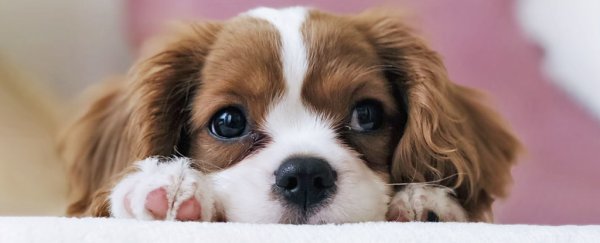With just the power of one beseeching, big-eyed look, dogs can wrap us around their perfect little paws. As it turns out, this ability is at least partially our own doing.
Recently, a team of researchers figured out the 'eyebrow' muscles that contort canine faces into adorable pleading expressions are not typically present in wolves, suggesting they arose after we humans domesticated Canis familiaris.
"The raised inner eyebrow movement in dogs is driven by a muscle which doesn't consistently exist in their closest living relative, the wolf," said Duquesne University anatomist Anne Burrows at the time.
 (Anne Burrows, Duquesne University)
(Anne Burrows, Duquesne University)
"This movement makes a dog's eyes appear larger, giving them a childlike appearance. It could also mimic the facial movement humans make when they're sad," added evolutionary psychologist Bridget Waller from the University of Portsmouth, United Kingdom.
But the way we've changed our clever canine friends is more than skin deep.
Burrows and colleagues have since built on their eyebrow research, finding that dogs not only have different muscles to wolves, but the structure of their face muscles differs as well. Even the internal composition of dog facial muscles has changed to look uncannily like our own.
The stained samples from the muscle around the mouth (orbicularis oris) below reveal dogs and humans both have more fast-twitch muscle fibers (dark blobs) relative to slow twitch fibers (light blobs), whereas it's the opposite for wolves.
 Wolf, dog, and human with corresponding muscle tissue samples. (Anne Burrows/Duquesne University/iStock.)
Wolf, dog, and human with corresponding muscle tissue samples. (Anne Burrows/Duquesne University/iStock.)
As implied, fast-twitch fibers respond quickly – perfect for raising eyebrows or barking – but they also fatigue faster. The slow-twitch muscles hold sustained movements for longer, like those required for a wolf's howl.
"These differences suggest that having faster muscle fibers contributes to a dog's ability to communicate effectively with people," said Burrows. "Throughout the domestication process, humans may have bred dogs selectively based on facial expressions that were similar to their own, and over time dog muscles could have evolved to become 'faster,' further benefiting communication between dogs and humans."
Back when our bond with these animals began, during humanity's hunter-gatherer days up to 40,00 years or so ago, it is clear that quick interspecies communication provided a survival advantage against mutual predators.
With such strong pressure to better communicate with humans, natural selection also honed dogs' abilities to understand us; in some ways, perhaps even better than we can understand each other. For starters, our canine companions can tell when we're lying and instinctively sense and react to our moods.
"Dogs are unique from other mammals in their reciprocated bond with humans, which can be demonstrated through mutual gaze, something we do not observe between humans and other domesticated mammals such as horses or cats," said Burrows.
Our long shared history with these animals has created a partnership unlike any other, which has developed and thrived through millennia of changes to still provide us with numerous benefits today. Over this time, dogs have influenced our evolution, too – our bond is written in our genes.
It is well established that humans, even at a young age, are innately drawn to a childlike facial appearance – a set of infant traits known as the 'baby schema'. These features include a comparatively large head compared to body size, large eyes, and small nose – traits shared by many baby animals, including dogs' and our own.
Brain scans have revealed baby faces – regardless of how related they are to us – hit us right in our neurophysiology. They turn on our nurturing behavior. Data from animal shelters suggests this also applies to dogs: those that have facial features with enhanced baby schema are more likely to be adopted.
Unfortunately, our innate penchant for human-baby-cute has also led to great suffering among some of our beloved pets. While gradually deforming some breeds to the shapes of our whims, over many generations we've inadvertently left them with severe medical problems.
Breeding for smaller dogs (with larger heads) has also caused some breeds to become more prone to heart disease. Breeding for flatter, baby-like faces has left others like pugs and bulldogs struggling to perform the most basic everyday function: breathing.
You can see just how shockingly much we've messed with some breeds in just over 100 years here. The good news is, now we're aware of how powerfully we can shape their evolution, we can make better choices for them. We owe dogs that much, at least.
The preliminary muscle structure findings were presented at the American Association for Anatomy annual meeting.
